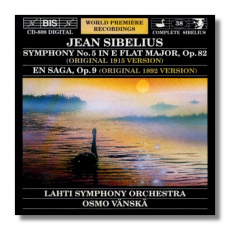
The Internet's Premier Classical Music Source
Related Links
- Sibelius Reviews
- Latest Reviews
- More Reviews
-
By Composer
-
Collections
DVD & Blu-ray
Books
Concert Reviews
Articles/Interviews
Software
Audio
Search Amazon
Recommended Links
Site News
 CD Review
CD Review
Jean Sibelius

Original Versions
- Symphony #5 in E Flat, Op. 82 (1915 version)
- En Saga (1892 version)
Lahti Symphony Orchestra/Osmo Vänskä
BIS CD-800 DDD 58:05
As most Sibelians will be aware, the familiar version of the Fifth Symphony (today probably the most popular of the seven) is in fact the third, dating from 1919.
But Sibelius originally completed the symphony in time for his 50th birthday concert in 1915. There are grounds for suspecting that the composer rushed to finish the symphony in time – probably one reason why he was dissatisified with the original version, which was almost immediately withdrawn and has apparently only been heard in public on one subsequent occasion. A further two revisions followed, resulting in the now-familiar version first heard in 1919.
Now, as with their groundbreaking recording of the original version of the Violin Concerto (CD-500), the Swedish company BIS have secured permission from the Sibelius family to make the première recording of the composer's first thoughts.
The "conventional wisdom", as propogated by liner-note writers, gives the impression that betwen 1915 and 1919 Sibelius did little to the symphony other that collapse the first two movements together. But, as listening to this disc – a somewhat disconcerting experience – amply demonstrates, Sibelius did far more than simply conflate the first two movements into one: he trimmed down the entire score – the finale alone is some 200 bars longer in the original – and made extensive changes; but most of the familiar material is still here, in one form or another.
Moreover, the nature of the changes themselves is very dramatic: the very opening of the symphony lacks its familiar horn-call, which today seems an intergral part of the fabric of the opening movement; nor does the original second movement begin where I – and I suspect many others – had always imagined, in the context of the final version, that it did.
Sibelius's genius shows itself most clearly, I believe, in the way in which he fused the original first two movements into one seamless whole; and perhaps his master stroke was that horn call, which now reveals itself to be derived from material originally in the second movement. This helps give the revised opening movement its essential unity and singlemindedness.
Elsewhere the changes are perhaps less dramatic – although I'm not so sure in the case of the finale. The slow movement contains mainly the same material although Sibelius re-ordered it in the revision.
The finale though, in its massively extended form, is very different. All the familar pieces are there, but the jigsaw is somehow distorted by the additional, unfamiliar ones which go to make up a rather more rambling whole than the taught, at times almost gnomic (especially the last bars) structure we know and love.
And what of those famous closing chords? Variously described as 'enigmatic', 'profoundly original' and 'exultant', once again we find that the main material is already in place in the first version; it is simply – simply! – the context which Sibelius changes. To explain further would be to deprive listeners of one of the great thrills of hearing this version for the first time.
Few, though, will be in any doubt that the revisions were for the better, making a fine work into a great masterpiece, but hearing this work in its original garb makes one's appreciation of the final work all the greater.
En Saga was Sibelius' first great purely orchestral success, although he was not entirely satisfied it and revised it a decade after the first performance before conducting it himself in Berlin in November 1902.
This earlier version is more discursive than the revision, yet the superiority of the later version is not so clear-cut a matter as with the symphony, for En Saga was a young man's work and the original is arguably a fresher creation.
This disc would be important even if the performances were no more than adequate. But they are far more than that. Vänskä turns in compelling, highly convincing accounts of both works, the Lahti Symphony play with great authority and the recording is up to BIS's usual high standards.
I cannot imagine any lover of the music of Sibelius wanting to be without this disc.
(I see that BIS has also reissued this coupled with Vänskä's more recent recording of the official version of the Fifth. This probably represents better value for money in terms of playing time, but I'd hate to be without that original En Saga.)
Copyright © 1996, Deryk Barker




















